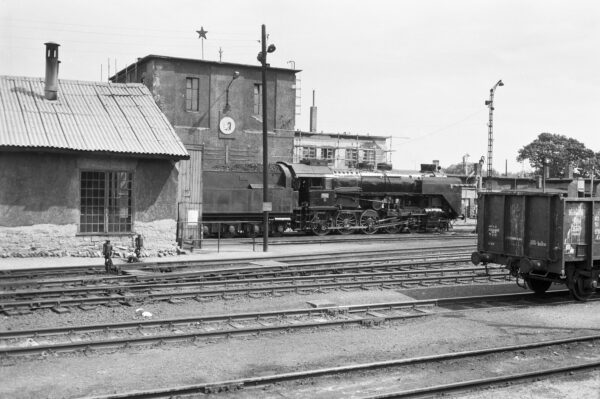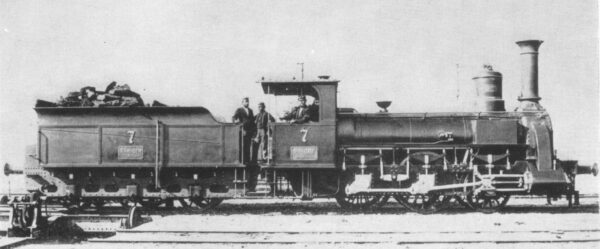Hungarian Western Railway

For the construction of the Székesfehérvár-Szombathely-Graz railway and the Celldömölk (then Kis Cell) Győr branch line, the Hungarian General Credit Bank in Pest and the Vienna-based Weikersheim M. H. and Company applied for a permit, which was granted to the applicants by Article V of Act V of 1869.
The railway was built with interest rate hedging. As the railway involved two states, separate agreements were concluded with the respective governments for the Hungarian and Austrian sections. The Hungarian government guaranteed a revenue of HUF 36400 per mile - i.e., it has so far supplemented the revenue - while Styria guaranteed a profit of HUF 51,3 billion per mile of the originally calculated construction cost of HUF 719,800 per mile for the Austrian section.
In Hungary, the main line was 234.8 kilometres long, the Celldömölk-Győr branch line was almost 70 kilometres long, while the section of the line in Austria was 36 kilometres long, making the total length of the network almost 373 kilometres.
The licence was granted for the usual 90 years, with the same clauses as for other railways, i.e. that the state could redeem it at any time after 30 years, and that if the traffic on a section exceeded 120 000 crowns, the joint stock company was obliged to build a second track immediately after the interest insurance expired.
During the project, it became clear that the construction amount provided was not enough due to the rebuilding of the Graz station, so the construction cost per mile was increased to the Hungarian amount of HUF 728 000 for the Austrian section as well.
The joint-stock company was founded on 18 May 1870 with 15 million shares and 21 million forints in preferred loan capital. 37,500 shares were issued at a price of 83%, which was heavily oversubscribed.
On the Hungarian section, the Győr-Szombathely section opened on 1 October 1871, followed by the Veszprém-Székesfehérvár section on 9 August 1872.The entire Hungarian line was completed on 3 October 1872, while the Austrian line was opened a little later, on 1 May 1873.
The railway started off with financial difficulties, and in 1874, to cover the shortfall, permission was sought to issue a further 3,276,400 forints in bonds. This was only partially granted. As many railway companies were in difficulty at the time, after the Vienna stock market crash of 1873, the Hungarian State was authorised to support railway companies in difficulty by two laws, Act XLI of 1875 and Act XI of 1876. Using this legal authorisation, it also granted 571 000 forints to the Hungarian Western Railway.
Despite the fact that the line was an important rail link, it was not profitable enough to repay the capital repayment plan set out in the contract with the government, which meant that the interest rate insurance had to be maintained. To remedy this, the railway company made several attempts. One of them was to apply for the construction of the Győr-Buda railway line in 1873, but this was ultimately prevented by the Vienna crash, and the state finally built this connection by buying the plans already drawn up by the Hungarian Western Railway.
In 1885 the railway's contingent debt amounted to 373 510 forints, the value of the share coupons was reduced, and new loans had to be taken out. To increase revenues, in 1888 the railway took over the operation of the local railways built in its area. This did not help profitability. It should be added that, although the line was completed by 1873, extensions and the rebuilding of the earlier wooden bridges in the 1880s for more permanent structures, such as iron, meant additional expenditure. In 1889, the State indicated to the railway company that it wished to exercise its rights, but it did not intend to nationalise the railway company, but only to take over the works for MÁV. The company, however, requested that the line be privatised instead. As a result, on 1 January 1889, the Hungarian state redeemed the Hungarian Western Railway and the network was taken over by MÁV.
Interesting facts
The fact that the railways were nationalised did not mean that the joint stock company ceased to exist. The redemption agreement stipulated that the company would be given 146,276 forints per annum up to the amount of the interest insurance up to the amount of 1,480,766 forints 59 kroner until 1962 to redeem the shares and bonds, and 146,276 forints per annum until 1941 to redeem the loan taken out in 1874, although the state reserved the right to redeem the shares and bonds at any time. Dividends were paid until 1944, after which the company was wound up by decision of the general meeting of 22 June 1944.
Although the Hungarian Western Railway passed through Veszprém, the station is relatively far from the city. This problem was also solved by the Győr-Veszprém-Dombóvár local interest railway, a small branch line of which also reached the centre of Veszprém. The 1895 Licensing Act explicitly stated that this line had to include the town of Veszprém. This section of the line opened in 1896, effectively creating two Veszprém railway stations: in 1898, the station on the old line of the former Hungarian Nyugoti Vasút became Veszprém Jutas station, while the station in the town became Veszprém station. This was the case until the closure of the branch line in 1972.

Literature
- Hungarian Railway History 1-3 (Editor-in-Chief Dr. László Kovács) MÁV, Budapest, 1995
- Vörös L. (ed.): Hungarian Railway Yearbook 1-6 (1878-1885)
- A century and a half ago, the Hungarian Western Railway built a railway from Veszprém to Kis-Cellig iho.hu
Date of foundation: 1869
Date of cessation: 1944
Founders: Hungarian General Hitelbank and Weikersheim M. H. & Co. of Vienna
Securities issued:
| Hungarian Western Railway |
Decisive leaders:
1869-1890 | Count Ede Zichy |
Main activity: railway services
Author: by Domonkos Csaba
Date of foundation: 1869
Founders: Hungarian General Hitelbank and Weikersheim M. H. & Co. of Vienna
Decisive leaders:
1869-1890 | Count Ede Zichy |
Main activity: railway services
Main products are not set
Seats are not configured
Locations are not set
Main milestones are not set
Author: by Domonkos Csaba
Hungarian Western Railway

For the construction of the Székesfehérvár-Szombathely-Graz railway and the Celldömölk (then Kis Cell) Győr branch line, the Hungarian General Credit Bank in Pest and the Vienna-based Weikersheim M. H. and Company applied for a permit, which was granted to the applicants by Article V of Act V of 1869.
The railway was built with interest rate hedging. As the railway involved two states, separate agreements were concluded with the respective governments for the Hungarian and Austrian sections. The Hungarian government guaranteed a revenue of HUF 36400 per mile - i.e., it has so far supplemented the revenue - while Styria guaranteed a profit of HUF 51,3 billion per mile of the originally calculated construction cost of HUF 719,800 per mile for the Austrian section.
In Hungary, the main line was 234.8 kilometres long, the Celldömölk-Győr branch line was almost 70 kilometres long, while the section of the line in Austria was 36 kilometres long, making the total length of the network almost 373 kilometres.
The licence was granted for the usual 90 years, with the same clauses as for other railways, i.e. that the state could redeem it at any time after 30 years, and that if the traffic on a section exceeded 120 000 crowns, the joint stock company was obliged to build a second track immediately after the interest insurance expired.
During the project, it became clear that the construction amount provided was not enough due to the rebuilding of the Graz station, so the construction cost per mile was increased to the Hungarian amount of HUF 728 000 for the Austrian section as well.
The joint-stock company was founded on 18 May 1870 with 15 million shares and 21 million forints in preferred loan capital. 37,500 shares were issued at a price of 83%, which was heavily oversubscribed.
On the Hungarian section, the Győr-Szombathely section opened on 1 October 1871, followed by the Veszprém-Székesfehérvár section on 9 August 1872.The entire Hungarian line was completed on 3 October 1872, while the Austrian line was opened a little later, on 1 May 1873.
The railway started off with financial difficulties, and in 1874, to cover the shortfall, permission was sought to issue a further 3,276,400 forints in bonds. This was only partially granted. As many railway companies were in difficulty at the time, after the Vienna stock market crash of 1873, the Hungarian State was authorised to support railway companies in difficulty by two laws, Act XLI of 1875 and Act XI of 1876. Using this legal authorisation, it also granted 571 000 forints to the Hungarian Western Railway.
Despite the fact that the line was an important rail link, it was not profitable enough to repay the capital repayment plan set out in the contract with the government, which meant that the interest rate insurance had to be maintained. To remedy this, the railway company made several attempts. One of them was to apply for the construction of the Győr-Buda railway line in 1873, but this was ultimately prevented by the Vienna crash, and the state finally built this connection by buying the plans already drawn up by the Hungarian Western Railway.
In 1885 the railway's contingent debt amounted to 373 510 forints, the value of the share coupons was reduced, and new loans had to be taken out. To increase revenues, in 1888 the railway took over the operation of the local railways built in its area. This did not help profitability. It should be added that, although the line was completed by 1873, extensions and the rebuilding of the earlier wooden bridges in the 1880s for more permanent structures, such as iron, meant additional expenditure. In 1889, the State indicated to the railway company that it wished to exercise its rights, but it did not intend to nationalise the railway company, but only to take over the works for MÁV. The company, however, requested that the line be privatised instead. As a result, on 1 January 1889, the Hungarian state redeemed the Hungarian Western Railway and the network was taken over by MÁV.
Interesting facts
The fact that the railways were nationalised did not mean that the joint stock company ceased to exist. The redemption agreement stipulated that the company would be given 146,276 forints per annum up to the amount of the interest insurance up to the amount of 1,480,766 forints 59 kroner until 1962 to redeem the shares and bonds, and 146,276 forints per annum until 1941 to redeem the loan taken out in 1874, although the state reserved the right to redeem the shares and bonds at any time. Dividends were paid until 1944, after which the company was wound up by decision of the general meeting of 22 June 1944.
Although the Hungarian Western Railway passed through Veszprém, the station is relatively far from the city. This problem was also solved by the Győr-Veszprém-Dombóvár local interest railway, a small branch line of which also reached the centre of Veszprém. The 1895 Licensing Act explicitly stated that this line had to include the town of Veszprém. This section of the line opened in 1896, effectively creating two Veszprém railway stations: in 1898, the station on the old line of the former Hungarian Nyugoti Vasút became Veszprém Jutas station, while the station in the town became Veszprém station. This was the case until the closure of the branch line in 1972.

Literature
- Hungarian Railway History 1-3 (Editor-in-Chief Dr. László Kovács) MÁV, Budapest, 1995
- Vörös L. (ed.): Hungarian Railway Yearbook 1-6 (1878-1885)
- A century and a half ago, the Hungarian Western Railway built a railway from Veszprém to Kis-Cellig iho.hu